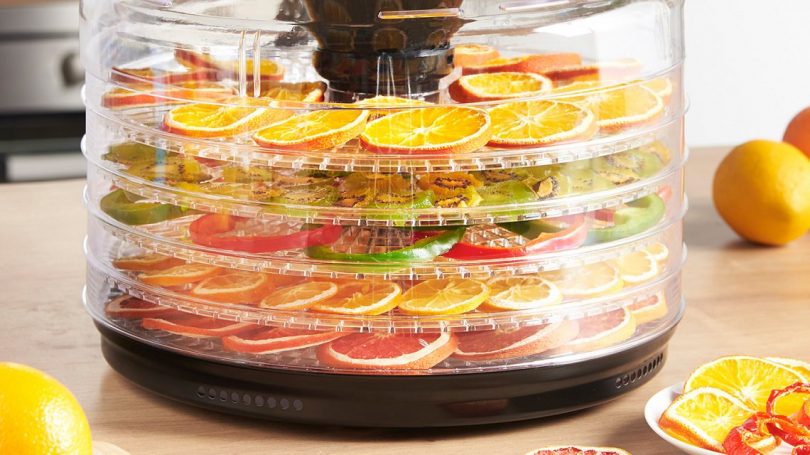A food dehydrator is a kitchen appliance that uses low amounts of heat and a built-in fan for drying or dehydrating food. It removes the water and moisture from your food without removing the nutrients in it.
Aside from eliminating water and moisture, it can also prevent the growth of bacteria and other microforms.
Read also: 10 Amazing Benefits of Dehydrating Food
Which Food Dehydrator is Right for You
Food dehydrators have different kinds, so it’s important to choose one that fits your needs. So, which one should you choose?
Stackable food dehydrators
Stackable dehydrators are also known as vertical dehydrators. They are composed of plastic trays that are stacked on top of each other.
These dehydrators usually have round trays, but some manufacturers choose to have square ones to use the space efficiently. The stacked trays are placed on a base unit that has a fan and a heating source. Their heat source is found either at the top or at the base of the dehydrator.
Stackable dehydrators are considered the most affordable – this is because their heat isn’t spread equally. This what the fan is for: to blow the heated air and spread the heat across all contents.
With stackable dehydrators, you may need to rotate the trays several times.
This is to make sure that all trays receive full heat and ventilation.
Shelf food dehydrators
Shelf dehydrators are somewhat similar to stackable dehydrators. The difference is the manner that the trays are placed – trays are placed on shelf slots, just like how they look like on your oven.
The process is still the same for shelf dehydrators: the dehydrator blows warm air across the food inside until it gets dry. With shelf dehydrators, the heating source and the fan are mounted on the wall. This set-up allows fresh heated air to be blown across all trays.
Shelf food dehydrators often have plastic trays and walls; there are some with metal components, while some are made from stainless steel. Don’t go for galvanized metal or aluminum for dehydrator trays because of the risk of corrosion; chemicals can also leak into food during the drying process.
Compared to stackable dehydrators, shelf dehydrators are easier to regulate and are more efficient.
Some of them are even insulated to stop heat loss. You can even dehydrate an entire batch without having to rotate trays, which can be very helpful if you’ll be leaving the house overnight or if you’re going out.
Industrial food dehydrators
You’ll often find industrial food dehydrators used by large companies. This is because dehydrators like these have larger capacities and can process bigger amounts of products.
Industrial dehydrators are high on wattage and power. They have automatic timers and thermostats so you’re sure to get the results you desire. Dehydrators can process as much as 42 trays at once – that’s why they’re perfect for your business. They’re usually made of stainless steel so they’re easy to maintain.
If you’re always storing food and in large amounts, then industrial food dehydrators are suitable for you.
If you’re a hunter who needs to store meat from your catch, then this will help you a lot.
You’ll also love this if you’re a part of a family who finds it difficult to maintain your food supply. You can just shrink the ingredients, store them, and take them out whenever you need them. You can even save money by preserving excess food.
Points to consider when choosing a food dehydrator
While looking for the perfect food dehydrator, it’s important to consider which machine will best fit your needs. You must figure out what types of food you will be drying, as well as how much.
- Go for a shelving device if you want to check your dried foods’ progress often.
- Stacking trays, on the other hand, will help you achieve flexibility in capacity.
Choose a dehydrator that has an adjustable thermostat, which allows you to set, change, and maintain the temperature. You know how important the temperature is when it comes to dehydrating foods – having something that will allow you to control it will help you a lot.
Helpful tips for using a food dehydrator
Take note of these helpful tips for using a food dehydrator.
The food has to be 95% dehydrated so that it can be stored properly
If your food items feel spongy, soft, or sticky, then return them inside the dehydrator for more time. If they’re breakable, hard, and crunchy, then they’re done.
Air conditioning, breezes, and high indoor humidity can affect drying time, so you must choose the right place for your dehydrator. It must be in a dry and warm place, and away from the air vents and windows.
Make sure to have the right temperature
Food dehydrators have varying times and temperatures, and it will also change depending on the food you’ll be dehydrating. Check the instructions on the label and/or instruction manual for times and temperatures.
Don’t rush the drying process
Don’t worry about your foods over-drying.
If you think you still need to dry them a little bit more, then do so, but you shouldn’t alter the temperature just to make them dry quicker. Altering the temperature will seal the outside but leave moisture within – your food can actually get spoiled before you get the chance to eat them.
Perform the necessary preparations
Foods should be washed before dehydrating. Wear gloves as you prepare to prevent your skin oils from getting into the food. Low-acid vegetables should be steamed for 10 minutes before dehydrating; they should be patted dry before placing them inside the dehydrator.
Be more efficient
Find ways on how you can manage your time well. Turn the dehydrator on and pre-heat it before use. Dehydrate those food items that require the same temperature and dry them at the same time. Food items should also be sliced to equal size and thickness.
Keep your home safe as you dry your foods
As previously mentioned, you have to choose the right area where your dehydrator will be placed. It’ll get hot, so it should be able to breathe. There shouldn’t anything above or behind it. You can place it outside, but you can’t store it outside.
Conclusion
There are three kinds of food dehydrators: stackable, shelf, and industrial. The first two are more commonly used by households while the third one is more suitable for drying larger batches of food. Choose which of the three is perfect for your dehydrating needs.
It all starts with the right food dehydrator so pick out which one works well for you. Make sure to follow the instructions stated in your dehydrator manual and perform the necessary preparations to ensure good results.





